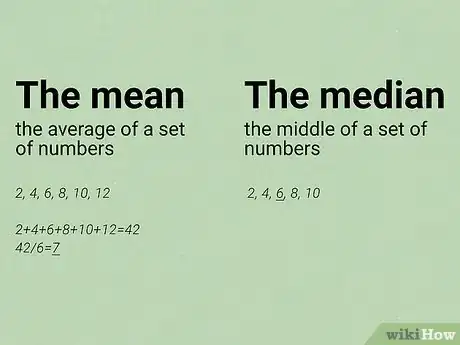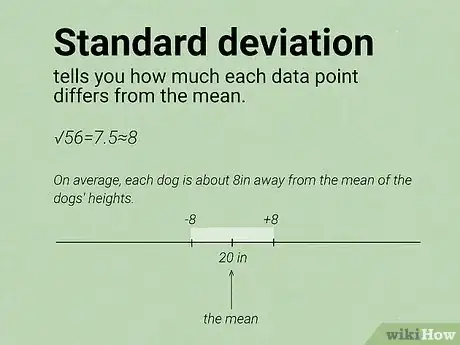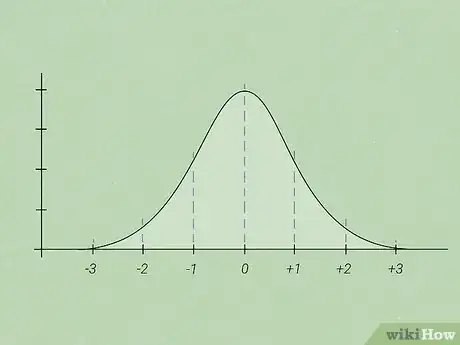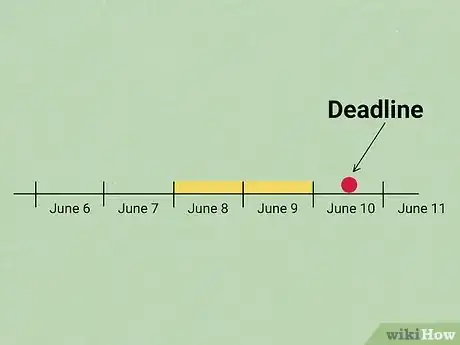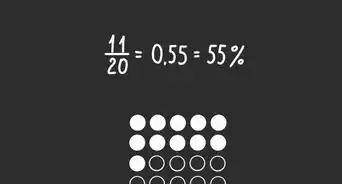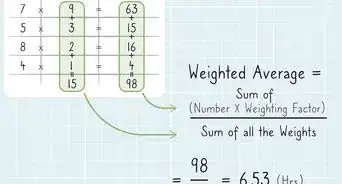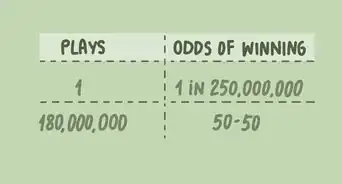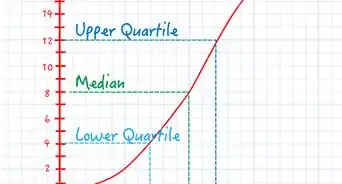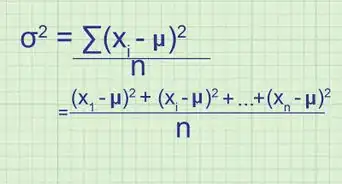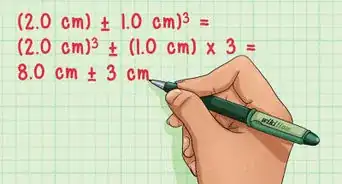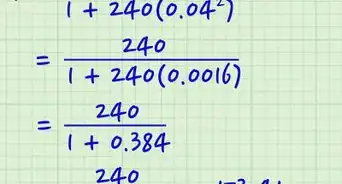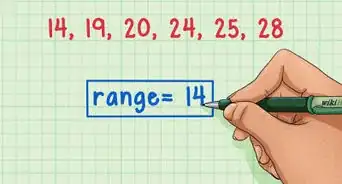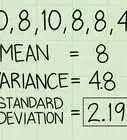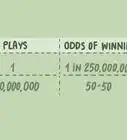This article was co-authored by Ronitte Libedinsky, MS. Ronitte Libedinsky is an Academic Tutor and the Founder of Brighter Minds SF, a San Francisco, California based company that provides one-on-one and small group tutoring. Specializing in tutoring mathematics (pre-algebra, algebra I/II, geometry, pre-calculus, calculus) and science (chemistry, biology), Ronitte has over 10 years of experience tutoring to middle school, high school, and college students. She also tutors in SSAT, Terra Nova, HSPT, SAT, and ACT test prep. Ronitte holds a BS in Chemistry from the University of California, Berkeley, and an MS in Chemistry from Tel Aviv University.
There are 8 references cited in this article, which can be found at the bottom of the page.
This article has been viewed 35,635 times.
You want to ace your statistics exam, but you’re not exactly sure how to study for statistics. Don’t worry—we’ve put together some of the best study tips for statistics that will really help you learn (and actually retain) the concepts and formulas you’re working with. We’ve also broken down some key statistics concepts that might be on your exam, like mean, median, variance, and standard deviation.
Steps
Studying Statistics
-
1Read each problem carefully. Each and every word and symbol in a statistics problem is important, and there can be a lot of information you need to absorb. To get all the information you need, read the problem slowly, and multiple times. If necessary, annotate the problem. Note what each part of the equation represents and what you're solving for.[1]
- For example, the equation for standard deviation is . Next to that formula, you might want to write the formula for the variance: ∑(X-µ2)/N
- After you've written out the variance formula, note what each component means. ∑ means "sum," the (X-µ) represents the difference between each term in the set and mean, and that N is the total number of points in the data set.
-
2Use pencil and paper while you study. When you get to parts of the text that explain a concept or formula, work them out yourself alongside the book, even if the book gives you the answer. Working through the problems as you study can help you really solidify the concepts you’re learning before you get to problems you’re expected to solve on your own.
- Even if you have no idea where to start, get your pencil moving and try to get through what you can. That way, if you need to ask for additional help, you can show your professor or tutor what you’ve already done.
Advertisement -
3Work out extra problems. Your instructor will likely set you homework that includes a few problems for each statistical concept you studied that week. If you find that 1 particular concept is hard for you, work out 2 or 3 extra problems on that concept. Being good at statistics requires actually doing the problems, so extra practice will always help.
- If you're not sure which extra problems you should do, ask your instructor. They can give you additional work from your textbook or workbook, or direct you to where you might find extra problems.
-
4Focus on concepts, not formulas. It's easier to learn statistical concepts – what each formula means and what it can help you figure out – rather than long, complicated formulas. Focus on learning the concepts behind the formulas – you can always look up the formulas later.[2]
Learning Basic Skills and Concepts
-
1Start with mean and median. Mean and median are 2 of the most basic statistical concepts, and they're foundational to other, more complicated concepts. The mean is the average of a set of numbers, and the median is the middle of a set of numbers. Your text book should cover these concepts – and how to calculate them – at the very beginning. You can also find instructions at on websites like MathWorld.[3]
- To calculate the mean, add all of the numbers in your data set and divide the sum by the number of numbers in the set. For example, if your data set includes the numbers 2, 4, 6, 8, 10, and 12, the sum of the set is 42. 42 divided by 6 (the number of data points) is 7. 7 is your mean.
- The median is the just the middle of any set of numbers. So the median of the data set 2, 4, 6, 8, and 10 is 6. If you have an even number of data points, add the 2 middle numbers of divide by 2.
-
2Learn the connection between variance and mean. Once you know how to calculate mean, you can move on to more complicated concepts. Variance is the average of squared differences from the mean. Knowing the variance can help you understand how spread out a set of data is.[4]
- For example, let's say you and your 3 friends each have a dog, and their heights are 12 in (30 cm), 20 in (51 cm), 16 in (41 cm), and 32 in (81 cm). First, take the mean of their heights by adding all 4 heights together and dividing by 4. In inches, this would be 12 + 20 + 16 + 32, which equals 80. Divide that by 4 (the total number of dogs) to get 20. So the mean of their heights is 20 in (51 cm).
- Then calculate the variance by subtracting each individual height from the mean and squaring it. So 20 - 12 is 8, and 8 squared is 64. 20 - 20 is 0, and 0 squared is still 0. 20 - 16 is 4, and 4 squared is 16. And 20 minus 32 is -12, and -12 squared is 144. 64 + 0 + 16 + 144 = 224.
- To get the final variance, divide the sum of the squared differences from the mean (224) by the number of dogs (4). So the variance of this data set is 56.
-
3Understand the connection between variance and standard deviation. Standard deviation tells you how much each data point differs from the mean. To calculate the standard deviation, you'll need the variance first. Then take the square root of the variance. If the resulting number includes a decimal (most will), round it to the nearest whole number.[5]
- For example, if the variance of your and your friends' dogs' heights is 56, the standard deviation is the square root of 7.5. You'd round that up to 8. That tells you that, on average, each dog is about 8 in (20 cm) away from the mean of the dogs' heights.
-
4Learn to calculate normal distribution. The normal distribution is a graphic distribution of a set of data's mean and the variations from the mean. You can learn a lot about a data set from normal distribution graphs. To learn how to calculate them, you'll need to calculate z values – individual points on the graph. A table of z-values can usually be found in your text book.[6]
- Your textbook should have detailed instructions on how to calculate points on a normal distribution graph. You can also find resources online, at websites like minitab or MathWorld.
Applying General Study Habits
-
1Take a break from difficult problems. If you’re really stuck on a problem or concept, give yourself a little bit of a break. Sometimes, when you get so focused, it can be hard to see the right answer. Take a break and go for a walk or do some chores and come back. The answer might be clearer to you then![7]
- The best study breaks are 15 to 20 minutes long. It gives your brain enough time to disengage a bit, but won't complete disrupt your studying.
-
2Review your notes regularly. Statistics is a very cumulative subject, meaning that each new concept or formula builds on the previous ones you’ve learned. So reviewing your notes once a week is a great way to prepare you for learning new concepts. Reread your notes and rework practice problems.
-
3Give yourself time to do your homework. If you’re rushing to get your homework done, you won’t really be absorbing the material. Do your homework the day or 2 before it’s due. That way, if you have any trouble, you have time to figure out the problems before the assignment is due.
-
4Listen carefully to your instructor. Your instructor will probably cover the most difficult, and the most important, concepts in class. Make sure you’re paying attention in class so you don’t miss anything important. If you find your attention starts to wander, refocus as soon as possible.
- To focus during class, remove any distractions: don’t bring your computer unless you need it, turn off your phone, and try to get a good night’s sleep the night before.
-
5Take detailed notes. Your instructor will go over a lot of practice problems in class. As you follow along, annotate your notes. Instead of just writing down the problem as your instructor does it, note how they get from one step to another. Use a highlighter to emphasize the concepts, rules, or techniques that your instructor emphasizes.
-
6Ask questions when necessary. As long as you’re really trying to understand the material, it’s perfectly okay to ask for help. Don’t worry about a question sounding dumb – everyone had to start somewhere with statistics, so even your teacher was where you are once.
-
7Keep your notes organized. Keep 1 notebook, or section of your notebook, just for notes from your statistics class. When you’re taking notes in class, make sure you always write them down in this same spot. You can also keep old quizzes and exams in the same place. Keeping your notes organized can help you when it’s time to study.[8]
-
8Start a study group. Chances are that some of your classmates will understand things you don’t, and you’ll understand things they don’t. Start a study group with a few other people from class, and get together to study once a week or so. You can help each other learn the material.[9]
Expert Q&A
-
QuestionWhy is statistics so hard?
 Ronitte Libedinsky, MSRonitte Libedinsky is an Academic Tutor and the Founder of Brighter Minds SF, a San Francisco, California based company that provides one-on-one and small group tutoring. Specializing in tutoring mathematics (pre-algebra, algebra I/II, geometry, pre-calculus, calculus) and science (chemistry, biology), Ronitte has over 10 years of experience tutoring to middle school, high school, and college students. She also tutors in SSAT, Terra Nova, HSPT, SAT, and ACT test prep. Ronitte holds a BS in Chemistry from the University of California, Berkeley, and an MS in Chemistry from Tel Aviv University.
Ronitte Libedinsky, MSRonitte Libedinsky is an Academic Tutor and the Founder of Brighter Minds SF, a San Francisco, California based company that provides one-on-one and small group tutoring. Specializing in tutoring mathematics (pre-algebra, algebra I/II, geometry, pre-calculus, calculus) and science (chemistry, biology), Ronitte has over 10 years of experience tutoring to middle school, high school, and college students. She also tutors in SSAT, Terra Nova, HSPT, SAT, and ACT test prep. Ronitte holds a BS in Chemistry from the University of California, Berkeley, and an MS in Chemistry from Tel Aviv University.
Math Tutor Well math is sequential, which is probably what makes statistics such a challenge for people. What I mean by that is that you can't learn specific high-level concepts without learning the building blocks first. So, before you can understand something like calculus, you need to understand variables, algebra, and other things. If there is a gap in your knowledge or you haven't fully mastered some of the building blocks, statistics can be a real challenge. Just get plenty of practice and find help if you need it. If you're willing to put the work in, there's no reason you can't master statistics!
Well math is sequential, which is probably what makes statistics such a challenge for people. What I mean by that is that you can't learn specific high-level concepts without learning the building blocks first. So, before you can understand something like calculus, you need to understand variables, algebra, and other things. If there is a gap in your knowledge or you haven't fully mastered some of the building blocks, statistics can be a real challenge. Just get plenty of practice and find help if you need it. If you're willing to put the work in, there's no reason you can't master statistics! -
QuestionWhat is an index number?
 DonaganTop AnswererAn index is a number that represents a trend within a set of other numbers. An example is the Dow Jones Industrial Average reflecting price trends in the U.S. stock market.
DonaganTop AnswererAn index is a number that represents a trend within a set of other numbers. An example is the Dow Jones Industrial Average reflecting price trends in the U.S. stock market.
References
- ↑ Ronitte Libedinsky, MS. Academic Tutor. Expert Interview. 26 May 2020.
- ↑ http://www.howtostudy.org/statsguide.php
- ↑ https://www.khanacademy.org/math/statistics-probability/summarizing-quantitative-data/mean-median-basics/a/mean-median-and-mode-review
- ↑ http://www.mathsisfun.com/data/standard-deviation.html
- ↑ http://www.mathsisfun.com/data/standard-deviation.html
- ↑ https://www.khanacademy.org/math/statistics-probability/modeling-distributions-of-data/normal-distributions-library/a/normal-distributions-review
- ↑ https://www.lib.sfu.ca/about/branches-depts/slc/learning/exam-prep/efficient-effective-study
- ↑ https://learningcenter.unc.edu/tips-and-tools/effective-note-taking-in-class/
- ↑ https://learningcenter.unc.edu/tips-and-tools/study-partners/






